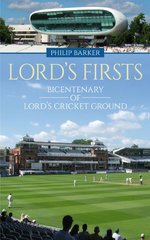Lord’s Firsts
Martin Chandler |Published: 2014
Pages: 224
Author: Barker, Philip
Publisher: Amberley Publishing
Rating: 3 stars

I have expressed surprise in the past about the number of books that have been written about the game’s spiritual home and most iconic venue, so my immediate thought on learning that Lord’s Firsts was about to be released was whether it could possibly add anything to the body of literature that is already out there.
The good news for publisher and author is that I believe that it can, and whilst the book has a flaw or two and doesn’t, as far as I can see, contain anything by way of original research, for anyone wanting to know more about the hallowed turf who doesn’t already possess one of the many books there are on the subject, then this is a good one to acquire.
I began the book, as I often do, by looking at the bibliography at the end. It was a source of some reassurance to note that only two of the numerous previous “histories” of the ground are referred to. The two that are mentioned are Plum Warner’s Lords 1787-1945 and Stephen Green’s 2003 book Lords; The Cathedral of Cricket. Warner’s book is, like all his writing, almost magisterial in style, accurate and straightforward, but essentially rather dull. Green’s is a book of photographs held together by a brief but skilful narrative. So no chance of any plagiarism.
At this point I perhaps ought to stress that my reference to an absence of original research is not meant to be an accusation of laziness towards the author. In fact it is clear that he has worked assiduously, no doubt using Warner’s book as a guide, to go back to original sources. The bibliography contains references to the work of the likes of John Nyren, Henry Bentley, William Epps and Arthur Haygarth, familiar names to anyone with an interest in the writings on the game that emerged in the 19th century.
As for Barker’s book he has told the story of the ground in 85 short chapters dealing with the most significant “firsts” to have occurred there. Some are obvious ones, such as the first match, the first century and the first appearance of WG. There are also references to the start of some of the great Lord’s fixtures; Gents v Players, Eton v Harrow and the Varsity match, as well as some more unusual games; Left Handed v Right Handed, The ‘B’s v England and Young v Old, defined in 1810 as “Under 38” v “Over 38”.
There is mention of other sporting pursuits the ground has hosted, and the first appearance of teams from all over the world. Those stories that relate to the major Test playing nations were amongst the more familiar tales that are told, but earlier than that were the first visits of sides from Ireland, Scotland and Wales. That theme provided what for me is the highlight of the book. In its penultimate entry Barker records the first visit from a Japanese XI, only last year. The MCC side contained a couple of former county players, so a strong combination, and the remarkable feature of the visitors team is that, if names are anything to go by, every man jack of them was a Japanese national and not, as I had expected, a group of ex-pats originating from the game’s main centres.
The book is in the nature of a miscellany, for dipping into at random, rather than something that needs to be read from start to finish, and being so short many chapters can be read in a couple of minutes. So an ideal companion for the commercial breaks and other interruptions that arise when watching cricket from an armchair.
The flaws I mention? Well the first is that I have to say I don’t much care for the way the match scores are set out. I appreciate that with space at a premium, and so many games to mention, a full scorecard for each match would be prohibitive, so I am content with the sort of potted scores that include just the totals, and a brief summary of the main individual contributions. What you have here though is an attempt to combine the two, by using the style of a potted score, whilst setting out all the individual innings, one after another separated by commas rather than line by line. For me it doesn’t work, although I would have to concede that others might prefer it, or at least not find it so irritating.
The other bugbear is the matter of accuracy. Whilst the book contained no factual errors that I could spot there were some strange things done with player’s names. Our leader will be horrified to see the name Archie McClaren, but at least that one, as in the case of Fred Truman, is a straightforward typo. But the error of calling the Yorkshire batsman of the inter-war period Edgar Holroyd rather than Oldroyd is rather more grating. Oddest of all, in that it can’t be put down to a slip of the tongue or sloppy proof reading, is the reference to George Tyldesley – not until a few years ago did Wisden acknowledge that Ernest’s first initial was in fact “G”, and throughout the annals of the game the only Lancastrian to complete a century of centuries has always been known simply as Ernest, but for some reason he is George here.
Of course part of the job description of a reviewer is to nitpick, and I can’t say that the points made in the preceding paragraph had much impact on my enjoyment of the book, unlike the choice of photographs, which I have no hesitation in describing as a very fine selection indeed, so this book is recommended, even for those who already own a book or two about Headquarters.






Leave a comment